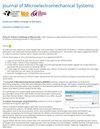A 27-nW Wake-Up Receiver With a Quartz Transformer Matching Network Achieving −71.9-dBm Sensitivity and −46-dB SIR at 0.8% Offset
IF 3.1
3区 工程技术
Q2 ENGINEERING, ELECTRICAL & ELECTRONIC
引用次数: 0
Abstract
This work reports the first ultra-low power wake-up receiver (WuRX) to be integrated with a quartz micro-electromechanical systems (MEMS) transformer-based matching network (MN), achieving the best signal-to-interference ratio (SIR) compared to state-of-the-art sub-100 nW receivers. A quartz resonant piezoelectric transformer (PT) was chosen for its high loaded一种带有石英变压器匹配网络的27-nW唤醒接收器,在0.8%偏移量下实现- 71.9 dbm灵敏度和- 46 db SIR
这项工作报告了第一个超低功耗唤醒接收器(WuRX)与基于石英微机电系统(MEMS)变压器的匹配网络(MN)集成,与最先进的低于100 nW的接收器相比,实现了最佳的信干扰比(SIR)。石英谐振压电变压器(PT)因其高负载Q值(~19,000)而被选择,从而实现大的无源电压增益——这是低功率无线电的必要条件,因为有源射频放大消耗太多功率。优化了CMOS包络检测器(ED)的输入阻抗和ED级数,保留了之前MEMS变压器的高Q值,同时保持了27 dB的高无源增益和50 MHz时2 kHz的窄带宽。石英PT设计用于从$50~\Omega $源到ED输入的最大电压增益。6级ED的输入阻抗大于1 M $\Omega $,转换增益为264.9 V-1,可在不清变压器的情况下最大限度地提高灵敏度。WuRX采用65纳米CMOS工艺实现,灵敏度为- 71.9 dBm,功耗仅为27 nW。由于变压器的窄带滤波,在0.8%的频偏下,测量到的SIR为- 46 dB。
本文章由计算机程序翻译,如有差异,请以英文原文为准。
求助全文
约1分钟内获得全文
求助全文
来源期刊

Journal of Microelectromechanical Systems
工程技术-工程:电子与电气
CiteScore
6.20
自引率
7.40%
发文量
115
审稿时长
7.5 months
期刊介绍:
The topics of interest include, but are not limited to: devices ranging in size from microns to millimeters, IC-compatible fabrication techniques, other fabrication techniques, measurement of micro phenomena, theoretical results, new materials and designs, micro actuators, micro robots, micro batteries, bearings, wear, reliability, electrical interconnections, micro telemanipulation, and standards appropriate to MEMS. Application examples and application oriented devices in fluidics, optics, bio-medical engineering, etc., are also of central interest.
 求助内容:
求助内容: 应助结果提醒方式:
应助结果提醒方式:


